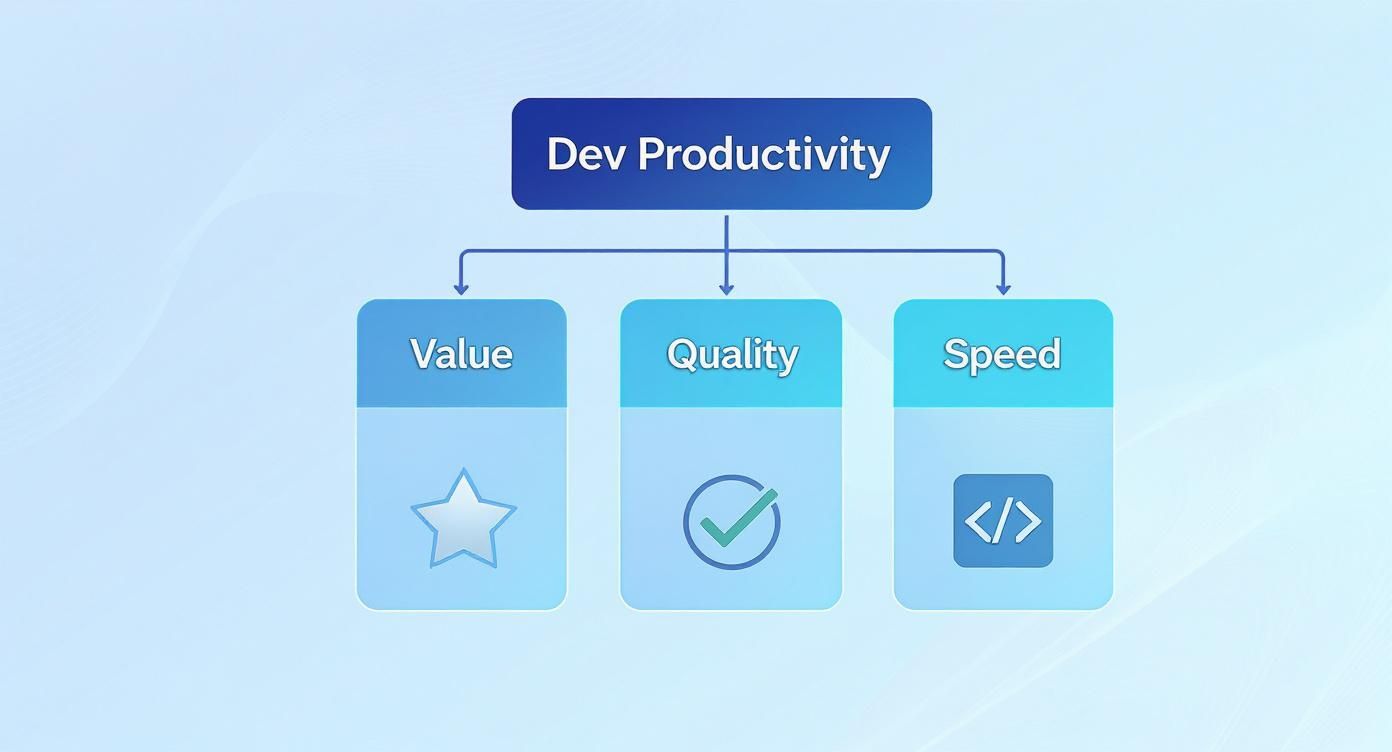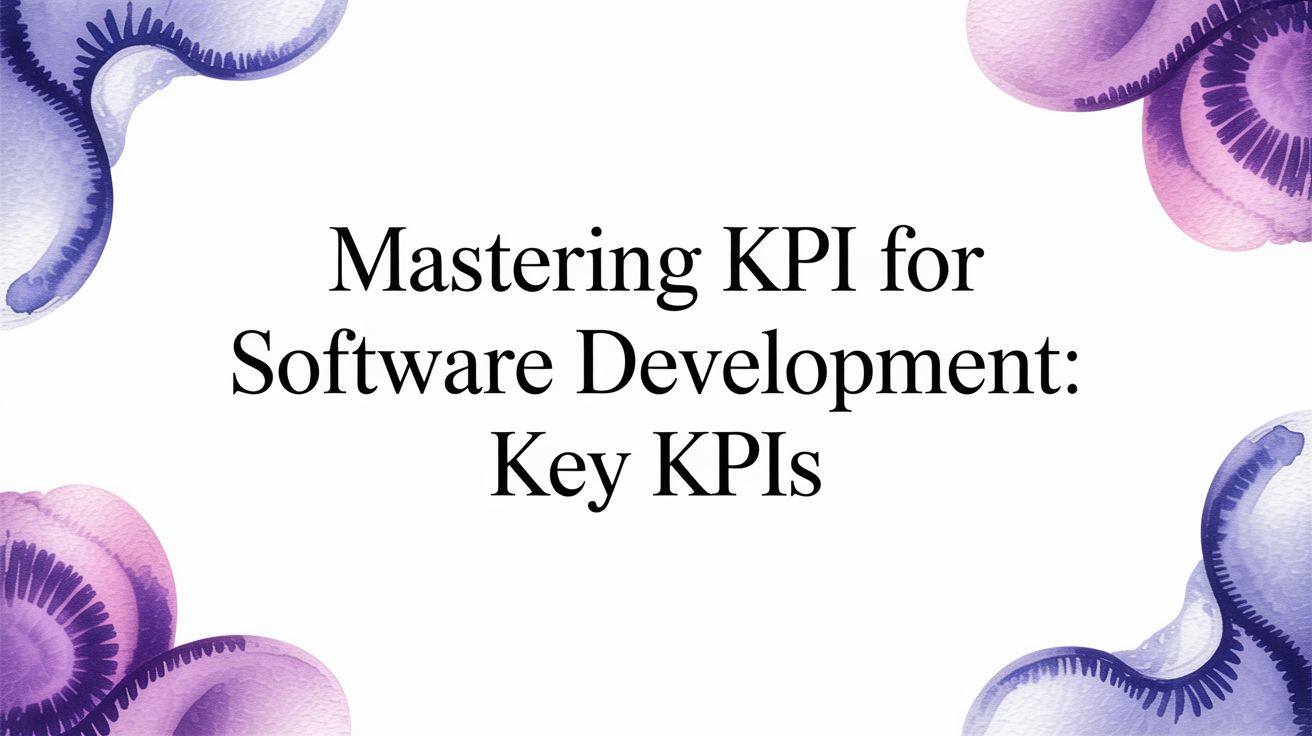For a long time, the software world got developer productivity all wrong. We measured what was easy to see, not what actually mattered. Redefining Developer Productivity Beyond Code Ask any old-school manager how they measured a developer's output, and you'd likely hear about lines of code, the number of commits, or how many tickets they […]

For a long time, the software world got developer productivity all wrong. We measured what was easy to see, not what actually mattered.
Ask any old-school manager how they measured a developer's output, and you'd likely hear about lines of code, the number of commits, or how many tickets they closed in a week. It was a factory-floor mentality applied to a creative, problem-solving discipline.
This approach is like judging a master chef by how many onions they chop. It completely misses the point. The chef's genius isn't in the prep work; it's in the final dish—the flavor, the artistry, and the experience it delivers.
The same goes for a great developer. Their real value isn't in how fast their fingers move, but in the elegance and impact of the solutions they create. A developer who spends a day thinking and then writes ten perfect lines of code to solve a complex problem is infinitely more productive than one who churns out a thousand lines of buggy, convoluted code.
This new way of thinking forces a shift in focus from mere activity to genuine impact.
True developer productivity is the efficient and sustainable delivery of high-quality software that solves real user problems and drives business value. It is a holistic measure encompassing not just code, but also collaboration, system health, and team satisfaction.
To really understand what makes developers productive, you have to look beyond the individual and see the whole system they work in. A truly productive engineering culture is built on three essential pillars:
When you adopt this value-first framework, you can finally leave behind those outdated and often harmful metrics. The goal is to build a culture where creating amazing software is just the natural result of a healthy, efficient process.
For a deeper dive into the core concepts and latest thinking in this space, you can find great resources on developer productivity. With this foundation, we can start exploring the specific metrics and strategies that help engineering teams achieve incredible results.
You can't improve what you don't measure, and that's especially true for developer productivity. But let's be clear: this isn't about creating a surveillance culture or counting keystrokes. The real goal is to use data to start meaningful conversations, pinpoint bottlenecks, and give teams the support they need to do their best work.
Good measurement is more than just collecting numbers; it's about actively asking better questions of your productivity data. When we shift the focus from individual output to team-level outcomes and overall system health, we get a clear, objective picture of what’s working and what isn’t. This approach helps teams celebrate wins together and tackle problems as a united front.
The diagram below breaks down the three core pillars of developer productivity, showing how everything flows from foundational speed to high-level business value.

As you can see, speed and quality aren't just buzzwords; they're the essential building blocks that make delivering real business value possible.
Two frameworks have become the gold standard for measuring what truly matters in software development: DORA and SPACE. They aren't an either/or choice. In fact, they complement each other beautifully, giving you a complete view of both your system's performance and the human element behind it.
Think of it this way: DORA is like the diagnostic check for your car's engine—it tells you how fast and reliable it is. SPACE, on the other hand, assesses the driver's well-being and ability to actually operate the car effectively. You need both to get where you're going.
The DORA metrics, made famous by the book Accelerate, zoom in on the technical performance of your software delivery pipeline. They provide hard, objective numbers that show how quickly and reliably your team can ship code.
The SPACE framework provides a much more holistic, multidimensional view. It acknowledges that true productivity is shaped by everything from developer satisfaction to collaboration. It helps you see the people behind the code, ensuring that any push for performance is sustainable and doesn't just lead to burnout.
DORA boils things down to four key metrics that are powerful indicators of elite DevOps performance. They measure the speed and stability of your development process, giving you a crystal-clear signal of your team's delivery horsepower.
These metrics give you a clean, quantitative look at your team's operational health. They're powerful because they are tough to game and are directly tied to delivering value to your users.
While DORA tells you "how fast and how stable," the SPACE framework answers a different, equally important question: "how is the team doing?" It provides a structure for understanding the nuanced, human-centric side of productivity for developers.
The acronym SPACE stands for:
Global surveys consistently back up this broader perspective. The 2025 JetBrains Developer Ecosystem Survey, which polled over 24,500 developers, found that satisfaction and efficiency are deeply connected to tools, workflows, and team dynamics.
Here’s a look at how these two essential frameworks stack up against each other.
| Framework Feature | DORA Metrics | SPACE Framework |
|---|---|---|
| Primary Focus | System performance and delivery throughput. | Holistic team health and individual well-being. |
| Key Metrics | Deployment Frequency, Lead Time, MTTR, Change Failure Rate. | Satisfaction, Performance, Activity, Communication, Efficiency. |
| Best Use Case | Identifying technical bottlenecks and optimizing the CI/CD pipeline. | Diagnosing team burnout, collaboration issues, or process friction. |
Both frameworks are incredibly valuable, but they solve different pieces of the productivity puzzle.
By combining DORA's system-level data with SPACE's human-centric insights, engineering leaders can create a balanced scorecard. This approach not only identifies technical bottlenecks but also uncovers hidden issues like burnout or poor collaboration that can quietly undermine a team's success.
To take the next step and turn these frameworks into concrete goals, check out our deep dive on choosing the right KPIs for software development. It's a practical guide to translating these powerful metrics into a real strategy for continuous improvement.

When we talk about making developers more productive, it's rarely about adding something new. It’s almost always about removing what’s getting in their way. Every engineering team has these silent productivity killers—little frictions and frustrations that quietly sabotage focus and turn a high-performing team into a sluggish one. These problems aren't usually dramatic failures; they're a slow, steady drain on a developer's most critical resource: uninterrupted time.
Imagine a developer’s focus is a deep pool of water. Every meeting, Slack notification, or shoulder tap is a pebble tossed in, sending ripples across the surface. A few are fine, but a constant barrage makes it impossible to see what's going on underneath. This is the reality for too many engineers, where the real challenge isn't the code itself, but carving out the time to actually write it.
These interruptions are just one piece of the puzzle. Recent data shows just how widespread these issues are: nearly 57% of developers cite unclear requirements as a major problem, and a staggering 55% of project delays stem from last-minute changes. These numbers tell a clear story—we need better systems to protect our developers' time and focus. You can dig deeper into these trends and other software development statistics in recent industry reports.
Of all the productivity drains, context switching is easily the most damaging. When you pull a developer out of a complex coding problem to answer a "quick question" or join an impromptu meeting, you’re not just taking five minutes of their time. You're forcing them to dismantle the intricate mental model they've built around the code—a delicate structure that takes a long, long time to rebuild.
It’s like asking a mechanic to stop mid-way through assembling a complex engine to go find a wrench for someone else. The real cost isn’t the interruption; it's the time and mental energy wasted getting back into the flow of the original task.
Protecting a developer's flow state is one of the highest-leverage things a manager can do. A single three-hour block of deep, uninterrupted work is often more valuable than an entire eight-hour day chopped up by meetings and alerts.
Another huge drain on productivity is ambiguous or incomplete requirements. When a developer gets a ticket that just says "build a new user dashboard," they're forced to become a mind reader. This kicks off a painful cycle of guesswork, rework, and wasted effort as they try to build something that matches a stakeholder’s fuzzy vision.
The good news is that you can fight back with a few simple, powerful habits:
Finally, let's talk about technical debt. It's the cost of choosing an easy, quick fix now instead of the right approach that would take longer. At first, it's just a minor annoyance, but if you let it pile up, it can make even simple changes slow, risky, and painful. Eventually, it grinds productivity to a near-halt.
A great way to manage this is to treat it like a financial budget. Allocate a fixed percentage of every sprint—say, 10-20%—to paying down that debt. This time can be spent refactoring old code, improving test coverage, or upgrading libraries. By consistently chipping away at it, you prevent debt from spiraling out of control and keep your codebase healthy and your team moving fast.

Individual brilliance is great, but it doesn't scale on its own. To really get a team moving, you need intelligent systems—a mix of smart processes and the right tools that get rid of friction and let developers do what they're paid to do: solve complex problems.
Think of it like building a highway for your development team. Without one, every developer is hacking their own path through rough terrain. It's slow, inefficient, and full of needless obstacles. But with a well-paved road—a set of supported tools and clear workflows—they can move at incredible speed. They know the path is clear, safe, and built for delivery.
This isn't just about going faster; it’s about making the right way the easy way. A good system naturally guides engineers toward best practices for testing, security, and deployment without them even having to think about it.
One of the biggest speed bumps on the development highway? The old-school code review. Sitting in long meetings to go over pull requests absolutely kills momentum. It creates massive bottlenecks, especially when you have a remote team scattered across the globe.
The answer is to lean into asynchronous code reviews. This simply means using tools like GitHub or GitLab to leave clear, contextual comments right on the code. The author can then address the feedback on their own schedule, which keeps the feedback loop tight without derailing everyone's focus time.
To make asynchronous reviews work, you need a few ground rules:
When done right, code reviews stop being a roadblock and start being a smooth, integrated part of the workflow.
Continuous Integration and Continuous Deployment (CI/CD) pipelines are the engine of any high-velocity team. They take the tedious, error-prone manual work of building, testing, and deploying software and turn it into a reliable, one-click operation.
A solid CI/CD pipeline is your safety net. Every time code is pushed, it automatically runs a whole suite of tests, catching bugs long before they ever see the light of day in production. This gives developers the confidence to ship changes quickly and often, knowing the system has their back.
A well-implemented CI/CD pipeline does more than just save time—it fundamentally changes team culture. It fosters a mindset of experimentation and rapid iteration, empowering developers to deliver value to users faster and with less risk.
The tools you pick matter a lot, but you have to be deliberate. The recent boom in AI coding assistants is a perfect example. A surprising early-2025 study found that experienced open-source developers using these tools actually took 19% longer to complete their tasks. This really underscores the need to evaluate any new tool carefully to make sure it actually helps your specific workflow. You can read the full research on AI's impact on developer tasks to dig into these nuances.
Getting the right tools in place is foundational. They form the backbone of a productive engineering environment, automating mundane tasks and enabling developers to focus on high-impact work.
| Tool Category | Purpose | Example Tools |
|---|---|---|
| Version Control | Manages and tracks changes to source code, enabling collaboration. | Git, GitHub, GitLab, Bitbucket |
| IDE & Editors | The primary environment where developers write and debug code. | Visual Studio Code, JetBrains IDEs (IntelliJ, PyCharm), Neovim |
| CI/CD | Automates the build, test, and deployment pipeline. | Jenkins, CircleCI, GitHub Actions, GitLab CI/CD |
| Project Management | Organizes tasks, tracks progress, and facilitates team communication. | Jira, Asana, Trello, Linear |
| Communication | Enables real-time and asynchronous collaboration for the team. | Slack, Microsoft Teams, Discord |
| Containerization | Packages applications and their dependencies into portable containers. | Docker, Podman, Kubernetes |
| Monitoring & Observability | Tracks application performance and health in production. | Datadog, New Relic, Prometheus, Grafana |
While this list isn't exhaustive, it covers the core areas where the right tooling can provide a massive lift to your team's velocity and overall happiness.
For distributed teams, a well-defined process isn't just nice to have—it's essential. You can't rely on hallway conversations or tapping someone on the shoulder when your team is spread across different time zones. Process and documentation become the glue holding everything together.
Success in a remote world boils down to mastering asynchronous collaboration. That means creating a single source of truth—a well-maintained wiki, clear project documentation, and a structured task management system. If you're building out your team, you might find our guide on the different roles in agile software development helpful for defining how everyone interacts in these environments.
By establishing clear communication protocols and making documentation a priority, remote teams can stay aligned and turn their geographic flexibility into a serious competitive advantage.
Let's be honest: even the best tools and processes in the world can't save you from a lack of talent. A high-performing engineering team isn't built by accident. It all starts with finding the right people.
We're not just talking about developers who look good on paper. A truly great developer brings a powerful mix of deep technical skill and a genuine spirit of collaboration. They're the kind of problem-solvers who make everyone around them better, not just the ones who quietly crush their own tickets. Spotting these individuals is the single most important investment you can make in your team's future.
Of course, finding them is the hard part. Elite talent is always in high demand, and the traditional hiring process can feel like a slow-motion crawl, leaving key roles open for months.
Once you’ve hired someone incredible, the clock starts ticking. The goal is to get them contributing meaningfully as fast as humanly possible. A fuzzy or disorganized onboarding process can leave a new hire feeling adrift and unproductive for months, which is a huge drain on their morale and your team's momentum.
A great onboarding experience, however, is a productivity multiplier. It can shrink a new developer’s time-to-contribution from a couple of months down to just a few weeks. This doesn't happen by chance; it requires a deliberate plan that gives them clarity and support right from day one.
A world-class onboarding process isn't just a series of meetings; it's a thoughtfully designed journey that systematically removes barriers. It empowers new developers to understand the codebase, the culture, and their role, enabling them to ship their first piece of meaningful code with confidence.
So, what does a solid plan look like? It usually includes these key elements:
This kind of structured approach turns onboarding from a passive orientation into an active, engaging process that sets people up for success from the get-go.
To keep the momentum going past that first week, a 30-60-90 day plan is your best friend. It creates a clear roadmap for what success looks like and gives both the new hire and their manager a shared script for tracking progress.
Building a world-class team takes a serious investment of time and energy. This is where a strategic partner can completely change the game. For companies trying to scale quickly without lowering their standards, platforms like HireDevelopers.com offer a massive advantage.
By giving you access to a pool of rigorously pre-vetted, elite global talent, you can skip the most draining parts of the hiring funnel. For more tips on finding great people, check out our guide on how to recruit the best engineers from around the world.
HireDevelopers.com speeds up the entire process by handling sourcing, vetting, and even the complexities of global payroll and compliance. This frees you up to focus on what really matters: integrating exceptional new engineers into your team and shipping product faster than ever. You get a shortlist of perfect candidates in hours, not weeks, letting you build a powerhouse team at the speed your business demands.
Trying to pin down developer productivity can feel like chasing a moving target. It’s a topic that leaves even seasoned engineering leaders scratching their heads. Let's cut through the noise and tackle some of the most common questions with clear, practical answers to help you build a truly effective team.
The short answer? You don't. At least, not in the old-school way.
Obsessing over individual metrics like lines of code or tickets closed is a recipe for disaster. It breeds a toxic, competitive culture where developers focus on hitting arbitrary numbers instead of collaborating to build great software. The real key is to zoom out and focus on team-level outcomes.
Instead of tracking commits, look at your team's collective success through frameworks like DORA. These metrics give you a clear picture of your entire system's health, not just one person's busywork.
So, where does individual performance fit in? It's best assessed through conversations. Use your one-on-one meetings to talk about a developer's real impact—how they’ve helped the team hit its goals, mentored others, or made processes better. That’s how you build a culture of shared ownership and genuine growth.
If you're looking for the single biggest lever you can pull, it's this: nail down your requirements. A staggering amount of engineering time gets vaporized when developers have to work with vague or constantly changing specs. Ambiguity is the enemy of momentum.
When you invest in a solid process for defining, documenting, and managing project requirements right from the start, you eliminate the guesswork. Developers are empowered to build the right thing, the first time. When everyone knows exactly where they're going, they get there a whole lot faster.
Not necessarily. While AI assistants like GitHub Copilot are fantastic for spitting out boilerplate code or handling routine tasks, their value drops as the work gets more complex. They’re powerful assistants, but they aren’t magic.
In fact, some recent studies found that experienced developers can take 19% longer to finish complex tasks with AI. Why? The time they spend carefully checking and debugging the AI's code can completely wipe out the initial time savings.
Real productivity gains come from using these tools for the right job—automating the repetitive stuff. This frees up your human developers to focus their brainpower on what they do best: creative, complex problem-solving.
The best remote teams run on two things: exceptional asynchronous communication and meticulous documentation. The goal is to create a single source of truth—whether it's a project wiki, a detailed design doc, or a well-organized task board—so that meetings become the exception, not the rule.
This approach gives developers the autonomy to find answers on their own and get into that deep, uninterrupted state of flow that is so crucial for complex work. By building a culture founded on trust, autonomy, and clear written communication, remote teams can turn their flexibility into a massive performance advantage.
TypeScript has become a core competency for modern software development. As its adoption skyrockets, so does the demand for engineers who can wield its type system with precision and strategic foresight. Demonstrating this expertise under interview pressure, however, presents a unique challenge that goes beyond recalling basic syntax. This guide moves past simple Q&A lists […]

In a world saturated with data, the ability to transform raw numbers into clear, actionable insights is a critical competitive advantage. For CTOs, product leaders, and engineering managers, effective data visualization serves as the essential bridge between complex datasets and strategic decision-making. A well-designed chart can reveal hidden trends and empower teams to act decisively, […]

Think of Key Performance Indicators (KPIs) not as a high-school report card, but as the flight dashboard for your engineering team. These are the critical instruments showing your speed, altitude, and direction, making sure you reach your destination—your business goals—safely and efficiently. At their heart, these are simply quantifiable metrics that track how well your […]
